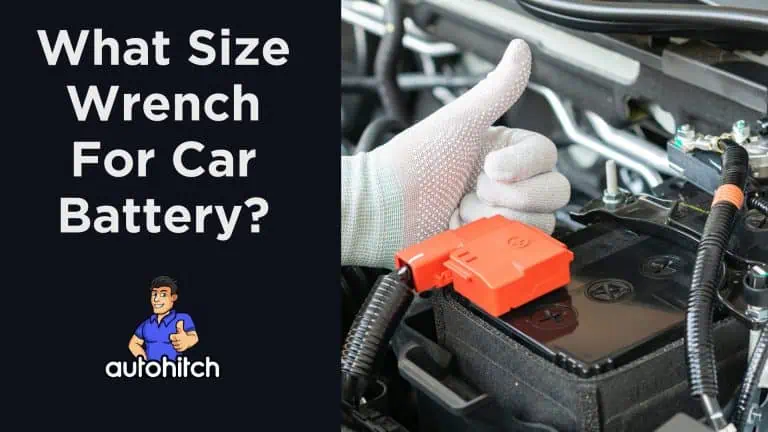When it’s time to replace your car’s battery, having the correct size wrench is important.
An improperly sized wrench can round off the battery terminal nuts, making the job much more difficult and potentially damaging your car.
Generally, car batteries use 10mm or 13mm terminal nuts.
To ensure you have the perfect fit, first inspect the terminals visually to identify their size. You can also check your owner’s manual or use calipers to precisely measure the nuts. Once you know the measurement, grab the appropriate wrench from your toolkit.
Related Articles To Read:
Table of Contents
Why Proper Sizing Matters
Choosing a properly fitting wrench matters for several key reasons:
- Prevents terminal damage: Ill-fitting wrenches strip bolts or slip off nuts.
- Enables proper tightening: Snug fittings ensure electrical connections aren’t loose.
- Improves safety: Correct wrenches give you more control and reduce accidents.
In addition to battery replacement, having various wrench sizes on hand aids general maintenance like cleaning corroded terminals or re-tightening loose connections.
Common Wrench Types and Sizes
While shopping for a car battery wrench, you’ll encounter several options:
Box-End Wrench
The standard wrench with enclosed ends. Useful for maximizing grip and torque but requires space to turn.
- Common sizes: 10mm, 13mm
Socket Wrench
Comprised of a handle with detachable, socket fittings. Versatile for various nut sizes.
- Common sizes: 10mm, 13mm
Adjustable Wrench
A single wrench with adjustable jaw size. Convenient but less secure grip.
- Common sizes: fits range including 10mm and 13mm battery terminals
Step-By-Step Battery Replacement
Once you’ve verified the terminal nut size and acquired the proper wrench, follow these key steps:
Gather Materials
- Wrench (10mm or 13mm)
- Replacement battery
- Terminal cleaner and brush
- Petroleum jelly/grease
- Gloves and goggles
Disconnect and Remove
- Disconnect negative (-) cable first
- Remove positive (+) cable
- Remove hold-down bracket
- Carefully extract old battery
Clean and Install
- Clean corrosion on terminals with baking soda solution
- Apply thin protective grease layer
- Place new battery into tray
- Reattach bracket tightly
- Connect positive cable then negative
Maintenance Tips
Proper battery care extends its lifespan. Follow these key maintenance practices:
- Regularly inspect terminals for corrosion or loose connections
- Clean any corrosion immediately with a baking soda/water mix
- Re-tighten connections to avoid vibration/electrical issues
- Apply protective coatings like petroleum jelly to prevent future corrosion
And when replacing your battery, don’t forget the essential safety steps of wearing protective gear, avoiding sparks near the terminals, and working in a ventilated environment.
Expert tip: A quick way to clean corrosion from a battery terminal is to pour a can of Coca-Cola on it. The acid in the soda dissolves and loosens the corrosion, but does not reverse it! Be sure to rinse with water after and apply dielectric grease to prevent future corrosion.
Key Takeaways
- Car batteries usually have 10mm or 13mm terminal nut sizes
- Using properly sized wrenches prevents damage and aids installation
- Various wrench types like box-end or socket wrenches fit battery terminals
- Routine maintenance helps avoid corrosion and electrical issues
- Safety gear and ventilation protects against battery acid and fumes
Frequently Asked Questions
Still have questions about selecting and using the right car battery wrench? Explore answers to these common FAQs:
What damage can the wrong wrench size cause?
Using an inaccurately sized wrench strips bolts or rounds off the nut edges. This can make it nearly impossible to detach cables or remove the battery.
How do I measure the terminal nuts if no manual exists?
A digital caliper offers precise nut or bolt diameter measurements. Locate the nuts where cables connect to battery posts to determine the accurate size.
Can an adjustable wrench work in a pinch?
Although adjustable pliers can loosen or tighten battery terminals, they risk slipping or “rounding” damage. Fixed box or socket end wrenches better grip terminals.
What exactly is a terminal cleaner?
Specialized tools with wire brushes clean corrosion and debris from battery post surfaces for optimal electrical contact. Some also apply protective lubricants.
Ensure Proper Sizing For Safety and Performance
Installing or changing an automotive battery poses risks from electrical shorts, chemical leaks, and component damage. Using precision-fit wrenches minimizes these hazards while enabling efficient repairs. Keeping multiple-sized wrenches available also prepares you to service various battery types.
Sources For This Article:
- https://www.reddit.com/r/cars/comments/cmtvwb/coke_to_clean_battery_cables/?rdt=49889
- https://www.quora.com/What-size-wrench-do-I-need-to-remove-a-car-battery
- https://vehiclefreak.com/whats-the-wrench-size-for-a-car-battery-and-other-tools-you-need/
- https://www.homedepot.com/c/ah/how-to-change-a-car-battery/9ba683603be9fa5395fab9090232265



